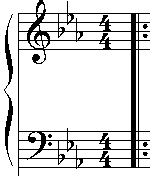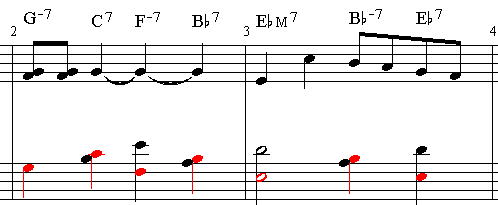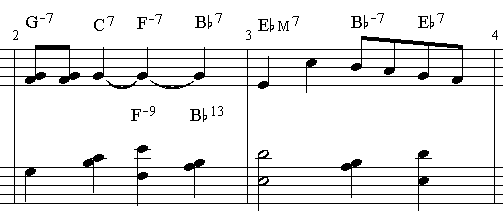Last time we took the Christmas song and developed a bass line for the basic chords and then added additional chords to create movement within measures two and three.

Your assignment for last week was to add bass notes and 7th intervals for the new chords we added in these measures. There are of course several choices you can make as to which note or 7th you want to add at each of these locations.
Let's look at what I decided to do and why I might chose some of these notes. Remember that this exercise is to explore music and the theory and that there are choices that you may or may not like. These are my personal choices and were developed as I was learning to arrange this song with my mentor.
 Remember that our key signature is Eb.
Remember that our key signature is Eb.
So that B, E and A notes are always flat unless we identify it otherwise.
.
Adding the Bass Lines to the New Chords

First off I changed the G7 whole note to a quarter note. And in this case I decided to try the 7th as two eight notes to give the start of the measure a little punch. Whether I keep this or tie them will depend on the audition I will do when I'm testing the arrangement.
Next, my first shot is to keep the bass notes in the upper part of the bass clef and keep them above low C. Let's look at just the bass notes shown in red. From the bass G note I jumped up rather than down to the C, then back down to the F, and back up to the Bb. Continuing on into the next measure I dropped to the Eb back Bb and then to Eb again. In measure four we will drop down to Ab, and we'll cover that a bit later.
So in measure 2 at the C7 I added the Bb as a minor seventh and used the inversion right next to C which I'll call the bump 7th, because the notes look like they are bumping into each other. At the F I added a minor 7th interval using the full distance for this one. Moving on to the Bb7 I added the Ab as another bump 7th.
As we go on into measure three I keep the pattern of far apart back to close, far, close. So we can see that the pattern continues. This is an interesting pattern and may add an odd bass sound to the song. It's worth trying just to see what it sounds like.
Treble Clef Notes and our Chords
So far we have only worked with the root and 7th notes of these chords. In measure 2 we have a continuous G note across all four chords. This makes complete since for the starting G-7 chord, but what of the others?
Chords are made of triads or 3rds. The C7 chord uses root, major 3rd, fifth and a minor 7th. So the chord notes are C E G Bb and the G is the fifth of the chord. a good fit. The F-7 chord, however, is F Ab C Eb, the G is not part of the basic chord. The G is a major 2nd. Or….
Since we have a 7th interval in the chord I've always used the simple rule that in most cases the even interval notes are going to be triad notes above the 7th. In this case it's the 9th, another 3rd above the 7th.
In the Bb we have even and more interesting note because the G is a 6th interval. Using the 7th rule with even intervals (7+6=13) so in this case we have a 13th in the chord.

In the third measure we have common chord tones, but there are a couple of notes that are outside the chords. These are passing tones and may be considered part of the chord if you wish to quantify them.
Assignment
Determine what the possible chord names are for the second and fourth beats are for your assignment this week.
Try out your base line and compare it to mine. What are the differences that you came up with? Remember neither is wrong you have choices as the artist. Some arrangements will be smooth others will be less so. What flow are you trying to achieve will be a question to ask yourself.
Next week we will go into measure 2 and work with voice leading the base line. Or taking the approach of creating a base line to smooth the flow of chord changes.
Stay tuned. And give me your thoughts on what we've done so far.
